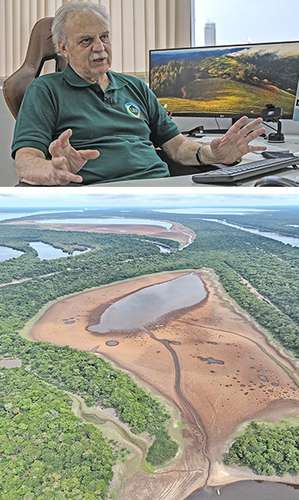Sao José Dos Campos. For years, Carlos Nobre maintained an optimistic discourse about the future of the planet. But the renowned Brazilian scientist now declares himself very concerned about the recent fast
increase in temperature, in the midst of the droughts and fires that hit South America especially hard.
The change in its position, he claims, is due to the fact that at the beginning of 2024 the world exceeded the warming threshold of 1.5 degrees compared to the pre-industrial era, according to data from the EU climate agency Copernicus, despite experts predicting that that figure, by itself very serious
would be recorded for the first time in 2028, maintains this climatologist. He has broken all records. We have to go back 120 thousand years to find this temperature, in the last interglacial period. This is of great concern
one of the greatest climate scientists in the Amazon tells AFP, in his office in Sao José dos Campos, near Sao Paulo.
Nobre, 73, co-president of the Scientific Panel for the Amazon (SPA) and former member of the UN Intergovernmental Panel on Climate Change (IPCC), comments on the rise in temperature: “Thousands of scientists are trying to explain why What went up so fast? The oceans have broken records, the waters are much warmer (…) the phenomenon The Child alone does not explain it. Greenhouse gas emissions did not decrease. In 2023 it broke records, in 2024 it will probably be higher. The Paris Agreement and COP26 in Glasgow in 2021 said that we had to reduce emissions by 43 percent by 2030 and reach net zero emissions by 2050, to not exceed 1.5 degrees. If we have already achieved it, this challenge will be much greater.”
–How will our lives be affected?
–Science already said that when 1.5 degrees were reached, climate phenomena would increase exponentially, it is not a slow linear increase. Heat waves, heavy rains, droughts, forest fires, melting ice, storms in the oceans, sea levels, everything would rise faster, exactly what happened in 2023. In 2024 we already see how the frequency of These extreme phenomena are accelerating and breaking records.
▲ The Brazilian climatologist and co-president of the Amazon Scientific Panel. Aerial view of a dry lake in Anavilhanas, Amazonas state. Several tributaries of the longest and largest river in the world are located in a critical situation
due to the historic drought that affects Brazil.Afp’s photo
–Currently South America, especially Brazil, seems to be the most affected region with an extreme drought linked to climate change that favors the spread of fires.
–The issue is global. The big difference is that in Canada and other places, almost all fires were natural, that is, electrical discharges that cause the fire to spread quickly because the vegetation is very dry. In the Amazon countries, more than 95 percent of the fires were caused by humans, so it is a very big difference (…) Fires are the way in which organized crime deforests (ndlr: especially for livestock farming) , after deforestation was significantly reduced last year. The criminals realized that satellites only detect fires when the fire affects an area of 30, 40 square meters. This gives them time to leave the area before being detained.
Deforestation and degradation
–You have warned that the Amazon is close to the point of no return towards savannization. Do fires accelerate the arrival to that point?
–Without a doubt (…) If global warming continues and we do not completely stop deforestation, degradation and fires, by 2050 we will have passed the point of no return. So, between 30 and 50 years, we will lose at least 50 percent of the forest. This will destroy the greatest biodiversity on the planet and will also release up to 300 billion tons of carbon dioxide into the atmosphere, making it even more difficult to keep the temperature at 1.5 degrees.
–Do you have hope that the situation will improve?
–It has to improve, there is no other solution. If we reach 2050 with 2.5 degrees of warming we can trigger the turning points: losing the Amazon, thawing a large part of the so-called permafrost (…) emitting hundreds of billions of tons of gases. If that happens, the planet will reach three or four degrees by the end of the century. With four degrees, the entire equatorial region will be uninhabitable, exceeding the limit of the human body. Paris, in the summer, would be uninhabitable (…) We will cause the sixth extinction of species.
